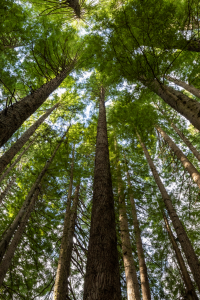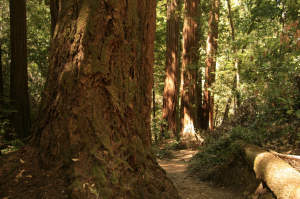Living in a Redwood Tree
Feeling cooped up with the lockdown?
Imagine living in a 200-ft-tall redwood tree for more than two years. Twenty years ago, Julia Butterfly Hill did just that, to draw attention to the continued clearcutting of California’s remaining redwood forests.
Hill did not set foot on the earth for 738 days. Instead, she learned to climb up and down the 1000-year-old redwood tree for exercise. She found she felt safer to climb barefoot, without climbing gear. Her feet developed muscles she hadn’t known they possessed.
She was cold and wet for much of that two years. There was no heat, no electricity. No artificial light. She had a sleeping bag, a solar-powered cell phone for media interviews, and a single-burner propane stove to cook and heat water. She had few necessities, and no luxuries.
Hill lived on two platforms, built from wood scraps and covered with tarps to theoretically keep the rain out. One measured 6 ft by 8 ft. The smaller one, 4 ft by 8 ft, was mostly used for storage.
She had occasional visitors – fellow tree-sitters staying over or bringing supplies, and other visitors including a couple of celebrities, as well as spiders, birds, and mice.
 A pair of resident flying squirrels specialized in keeping her awake at night by noisily investigating all her supplies.
A pair of resident flying squirrels specialized in keeping her awake at night by noisily investigating all her supplies.
Why, you might wonder, would anyone stay in a tree so long?
Hill had survived a bad car accident in Arkansas in 1996. It took a year of therapy for her short-term memory and motor skills to return. She said the experience was a wake-up call. Until then, her main focus had been work. “It became clear to me that our value as people is not in our stock portfolios and bank accounts, but in the legacies we leave behind.”
When she recovered, she resolved to travel and visit spiritual sites around the world. But first her neighbours invited her to join them on a driving trip to the West Coast. A stranger they met in passing told them they had to see the redwoods in California.
On arriving in the redwood forest, Hill says, “Gripped by the spirit of the forest, I dropped to my knees and began to sob… Surrounded by these huge, ancient giants, I felt the film covering my senses from the imbalance of our fast-paced, technologically dependent society melt away.
“I could feel my whole being bursting forth into new life in this majestic cathedral. I sat and cried for a long time. Finally, the tears turned into joy and the joy turned into mirth, and I sat and laughed at the beauty of it all.”
Even though Hill had just begun her travels, she felt called to try to protect the remaining majestic redwoods. Less than 3 per cent of the original forests were still standing, yet the logging continued.
At first Hill was unsure whether to trust this new calling. So she prayed to the Universal Spirit for guidance: “If I’m truly meant to come back and fight for these forests out here, please help me know what I’m meant to do, and use me as a vessel.” Soon, she found herself feeling at peace with the plan to stay, and received a sign she saw as the Universe’s approval.
Hill learned the logging was detrimental to people, as well as the forest. A hillside near Stafford, CA, had already been clear-cut. Just months before Hill arrived, a huge 20-ft-high mudslide carried trees, stumps and debris from that hillside down into the town, leaving seven families without homes. Despite evidence that clearcutting had destabilized the hillside and caused the mudslide, the Department of Forestry granted permission to continue logging on the very next slope.
That slope was where the tree which became known as Luna stood. The redwood was marked for destruction with a slash of blue paint. A group of activists had established a tree-sit, but were having trouble finding people to stay in it. The weather was getting colder. Base camp was being dismantled in preparation to end the protest for the winter. “I need somebody to commit for a long period of time,” the organizer told Hill. “At least five days.”
Hill did two five or six-day stints in the tree. But knowing Luna could be cut down as soon as the tree-sitters left, she wanted to do more. By staying longer, Hill felt, she could continue to draw attention to the plight of the redwood forests, and keep pressure on the logging company to change its plans and allow Luna and the surrounding grove to live.
Although the other activists were divided on whether or not to support her, five people promised to keep Hill supplied with food and necessities. She went up the tree on December 10, 1997. No one imagined how long Hill would end up staying in Luna, nor the trials she might have to endure.
 Early on, the logging company resolved to starve her out or drive her away. They hired 24-hour security guards to harass her and to ensure her support team couldn’t deliver her supplies. She was menaced with a helicopter at a dangerously close range. A neighboring tree was felled, hitting Luna’s outer branches and nearly causing Hill to fall. She was verbally abused, threatened with violence, rape and death, kept awake with floodlights, and bugles and air horns were blown through the night.
Early on, the logging company resolved to starve her out or drive her away. They hired 24-hour security guards to harass her and to ensure her support team couldn’t deliver her supplies. She was menaced with a helicopter at a dangerously close range. A neighboring tree was felled, hitting Luna’s outer branches and nearly causing Hill to fall. She was verbally abused, threatened with violence, rape and death, kept awake with floodlights, and bugles and air horns were blown through the night.
She began to hate the loggers, and even to hate herself, because she was part of the same human race that had so little respect for Nature. But knowing that hatred was part of the same violence she was trying to work against, Hill spent time praying for help.
One day after praying, she felt filled with love. She realized what she was feeling was the love of the Earth, the love of Creation: “Every day we, as a species, do so much to destroy Creation’s ability to give us life. But that Creation continues to do everything in its power to give us life anyway. And that’s true love,” she realized.
If Creation could do that for us, Hill decided, then she had to find within herself unconditional love even for the loggers. She began to talk to them as fellow humans, responding to abuse with songs or conversational questions.
A few weeks later it was New Year’s Eve, a time for resolutions. “Resolution is about resolve,” she thought. “My resolution… was to take a stand like the redwood tree, and not back down. Even after they’ve been chopped into the ground, redwoods don’t give up,” she said. “Instead they try to sprout new life.”
The months ahead held great challenges for Hill. The logging company wasn’t her only problem. One of her scariest times was a 16-hour, 70-mph windstorm, one of the worst Northern California storms in decades. The wind shredded the tarps that surrounded her, and even ripped huge branches off the tree. “Sleet and hail sliced through the tattered pieces of what used to be my roof and walls,” she wrote.
“Every new gust flipped the platform up into the air, threatening to hurl me over the edge. I was scared. I take that back. I was terrified. As a child, I experienced a tornado. But that was a walk in the park on a sunny Sunday afternoon compared to this.”
Clutching the branch that came through the middle of the platform, and so terrified she was afraid she might lose her mind, Hill prayed to Luna for help. “In that moment, I heard the voice of Luna speak to me. ‘Julia, think of the trees in the storm… They allow themselves to bend and be blown with the wind. They understand the power of letting go,” the voice told her.
That night, Hill felt she let go of her very self. When the storm departed, she no longer feared death. She felt she had undergone a transformation, like the nickname she’d had since childhood – Butterfly.
Many more experiences unfolded during those two years. Her feet once turned black with painful frostbite. When lightning struck nearby during an electrical storm, her hair stood straight up. Nearby helicopter logging made her ears ring for weeks. Then for six days, the leftover stumps and debris were set on fire on the entire slope. Her eyes swelled almost completely shut, and her throat and lungs burned from the thick smoke that surrounded her.
Thankfully, Hill also had many wonderful experiences. Despite the scorn often heaped on environmentalists, Good Housekeeping Magazine nominated Hill one of the most admired women in America. Striking steelworkers told her she had inspired them. Fifth and sixth-grade students from a school in Wisconsin corresponded with her, and even took action on her advice to reuse paper in order to protect forests. Hundreds of people wrote to thank her for bringing a spotlight to the issue of deforestation. She also had the ongoing support of her committed team, who hiked in for two hours each way, three times a week, to keep her supplied with food and necessities, sometimes having to outwit security guards in order to deliver them.
Finally, an agreement was reached with the logging company, and on December 18, 1999, Hill climbed down to once again walk on the earth.
With their willingness to sacrifice comfort and safety in order to bring the world’s attention to the last stands of California’s majestic redwood forests, Hill and her fellow activists left an important legacy. They were successful in saving Luna and some surrounding trees. Through their efforts, thousands more people learned about deforestation and its many ill effects.
As role models, Hill and her team showed us how we too could resolve to help Mother Nature, and follow through with long-term, committed action. Twenty years later, this is still an inspiring book, well worth reading.
The Legacy of Luna: The Story of a Tree, A Woman, and the Struggle to Save the Redwoods, by Julia Butterfly Hill is available from harpercollins.com for $15.99 US plus shipping.
A personalized, autographed book is also available for $30 US plus shipping from the author’s website, juliabutterflyhill.com.
